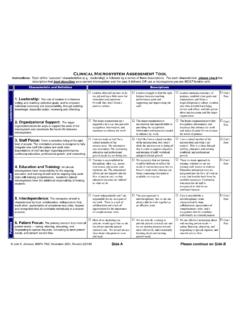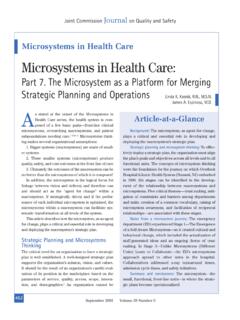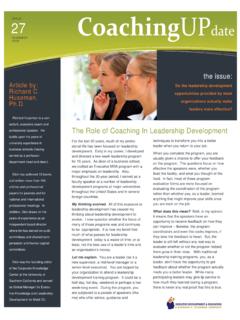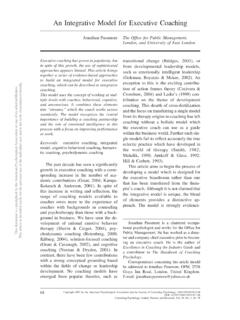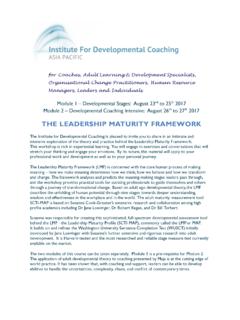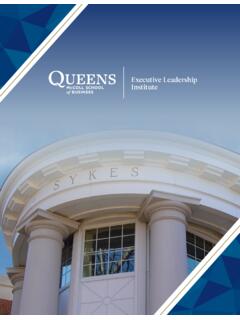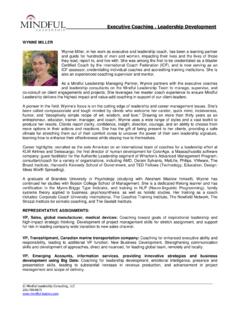Transcription of Evaluation of a Reflective Team Coaching Model as a ...
1 TEAM Coaching Model AND NURSE MANAGERS 1 Evaluation of a Reflective Team Coaching Model as a leadership Strategy for Nurse Managers to Cultivate Front Line Quality and Safety Improvement Capability Joan Clifford MGH Institute of Health Professions TEAM Coaching Model AND NURSE MANAGERS 2 Abstract Background The Institute of Medicine (IOM, 2010) recommends expanding opportunities for nurses to lead and diffuse collaborative improvement efforts. As leaders for the microsystem (unit) Nurse Managers are uniquely positioned to affect the outcomes of their work units, meeting quality and safety objectives. They need to be able to blend technical, managerial, communication, and relationship skills to promote quality and safety outcomes and require support for their role in leading and cultivating front line improvement.
2 Despite making progress in improving safety in healthcare, patient harm still occurs (Chassin & Loeb, 2013). Purpose The global aim of this project is to evaluate the impact of a team Coaching Model intervention on Nurse Managers' leadership development through enhanced knowledge and skill in quality improvement and outcomes of care. Sub aims of this project are (1) to evaluate the change in knowledge, abilities and skills over time and (2) to describe themes of leadership development from Nurse leaders who completed the program using final Coaching development plans and focus group. Design/Setting/Participants This project used a mixed method quality improvement design with a survey (quantitative) and focus group (qualitative) approach. Participants were five Nurse Managers in the acute care division of a multidivisional academic medical center in the Veterans Health Administration (VHA) in Roxbury Massachusetts.
3 TEAM Coaching Model AND NURSE MANAGERS 3 Intervention Coach the Coach (eCTC) program sponsored by the Dartmouth Institute Microsystem Academy, a 5-month intensive, dynamic, and highly interactive experiential learning series blending electronic and face-to-face formats to develop team Coaching knowledge, skills, and abilities. Results At the completion of the program (N=5) there were statistical differences in some of the variables, mainly in the improvement skills and measurement groups. There were no significant differences in the opinion or relationship groups of variables. There was significant change in 12/23 responses in the skills group and 4/12 responses in the measurement group. 6 months after completion of the program (N=3) analysis of the data of three points of time (pre (time 1), post (time 2) and 6 months post (time 3), determined the same results.)
4 There were no significant differences in the opinion or relationship groups as a whole and there was significant change in in the skills group and measurement group. Themes emerging from the focus group were (1) structure, accountability and encouragement (2) personal leadership skill development and (3) the art and science of Coaching was not infused into the day to day work of the nurse manager.. Conclusions Leaders at all levels can influence improvement at the front lines of care. A Reflective team Coaching Model is beneficial to the leadership development of Nurse Managers but requires an organizational structure that supports continued reinforcement and application of the TEAM Coaching Model AND NURSE MANAGERS 4 knowledge into daily practice. Creating a culture where improvement work truly becomes part of what leadership does is possible but takes commitment and help from all leadership levels.
5 Implications for Practice Nurse Managers need a variety of tools to be successful in managing and leading their units. Reflective team Coaching is an effective leadership strategy for Nurse Managers to gain knowledge and skills in the science of improvement and develop skills in the art of Coaching improvement within the context of a supportive culture. The skills associated with the art of Coaching improvement are useful in many situations involving group dynamics. Incorporating Reflective team Coaching into leadership development plans for Nurse Managers can assist in creating the conditions to cultivate front line quality and safety improvement capability. Nature and Significance of the problem Ensuring quality and safety in healthcare is a problem because we continue to cause harm in medical care in our healthcare systems (IOM, 2007).
6 Compounding the quality and safety concerns, inefficient systems of care contribute to the high cost of health care in the United States. Optimizing systems to reduce preventable harm is a national priority (AHRQ, 2015). The Institute of Medicine (IOM) reported medical errors cause up to 98,000 deaths and more than 1 million injuries each year in the United States at an estimated cost of $50 billion per year (IOM, 1999). Van den Bos et al. (2011) estimate that the annual cost of measurable medical errors that harm patients was $ billion in 2008. One of every 25 inpatients in acute care hospitals has at least one health care associated infection (Magill et al., 2014). Even with progress in safety improvements, there is more than can be done. There has been a 17 percent reduction in hospital acquired conditions from 2010 to 2013.
7 Hospital patients experienced million fewer hospital acquired conditions (HACs) over the 3 years, approximately 50,000 fewer TEAM Coaching Model AND NURSE MANAGERS 5 patients died in the hospital because of the reduction in HACs, and approximately $12 billion in health care costs were saved from 2010 to 2013. (AHRQ, 2015). Caring for the health and well being of people is important work and we have to do a better job of doing so safely and reliably. The clinical microsystem is a framework to assess and evaluate the structure, process, and outcomes of care (Mohr & Batalden, 2002). Nurse Managers are leaders for the microsystem (unit) and ensure that the unit meets quality and safety objectives. Uniquely positioned to affect the outcomes of their work units, Nurse Managers need to be able to blend technical, managerial, communication, and relationship skills to promote quality and safety outcomes.
8 However, research suggests that they often do not have adequate leadership skills to do so (Djukic, Kovner, Brewer, Fatehi, & Jun, 2015; Riles, Dis, Miller & McCullough, 2010). The Institute of Medicine (IOM, 2010) recommends expanding opportunities for nurses to lead and diffuse collaborative improvement efforts. Nurse Managers need support for their role in leading and cultivating front line improvement. Team Coaching , a three phase Model which incorporates theory, lived experiences of practitioners and experiential learning, is an effective method of increasing the improvement capability of frontline staff (Godfrey, 2013). This means creating an environment in which the frontline staff understand the structure, processes and outcomes of care in their clinical microsystem, can identify areas needing improvement and participate in efforts to coach these improvements.
9 Nurse Managers need to be confident in their own knowledge and skills in quality improvement to create this supportive environment for frontline staff. Therefore, the purpose of this project is to evaluate the impact of a team Coaching Model on Nurse Managers' skill and confidence in cultivating front line improvement. TEAM Coaching Model AND NURSE MANAGERS 6 Background Although one of the recommendations of the Institute of Medicine is to expand opportunities for nurses to lead and diffuse collaborative improvement efforts (Institute of Medicine, 2010) it is unclear if the structure to support this capability currently exists in acute care settings. Do we have the structure to support high performing clinical microsystems in the acute care units? A clinical microsystem is a small group of people who work together on a regular basis to provide care to discrete subpopulations of patients.
10 It has clinical and business aims, linked processes, and a shared information environment and it produces performance outcomes. Microsystems evolve over time and are often embedded in larger organizations. They are complex adaptive systems, and as such, they must do the primary work associated with core aims, meet the needs of their members and maintain themselves as clinical units. (Nelson, Batalden & Godfrey, 2007, ) leadership at all levels of the organization can affect the approach to deliver care at the front line. While the strategic direction for the organization may be towards a patient centered approach to care, front line staff need time, strategy, processes and tools to deliver quality care. Staff, Nurse Managers and those who supervise Nurse Managers need new knowledge to improve care. Just as there are traits associated with high performing organizations, so too are there characteristics of a high performing clinical microsystem (Nelson et al.)
